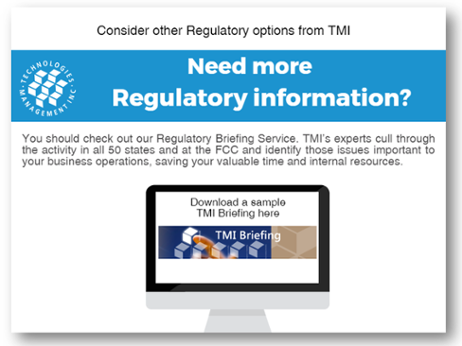 Today: Pennsylvania Reminds Users Of New Dialing Plan in 717 Area Code, US Senate Bill Proposes Rural Broadband Grants, New Report Measures Willingness To Pay For Certain Broadband Speed Features
Today: Pennsylvania Reminds Users Of New Dialing Plan in 717 Area Code, US Senate Bill Proposes Rural Broadband Grants, New Report Measures Willingness To Pay For Certain Broadband Speed Features
Pennsylvania Reminds Users Of New Dialing Plan in 717 Area Code
The PUC issued a Press Release reminding residents and businesses that the August 26 starting date for 10-digit dialing across the 717 area code is quickly approaching. The new area code – “223” – is being put into service because the remaining supply of available 717 telephone numbers is close to exhaustion. Residents and businesses across Central Pennsylvania should be prepared for the upcoming change. TMI Briefing Service subscribers see Briefings dated 1/20/17 and 11/11/16.
“Now is the time to be certain that all your phones and other devices are ready for 10-digit dialing – and to check that family members, friends and neighbors are also ready,” said Pennsylvania PUC Chairman Gladys M. Brown. “It is equally important to double-check devices like medical alert systems, alarm systems, and any other systems that automatically make calls, to be certain they are set.
US Senate Bill Proposes Rural Broadband Grants
U.S. Senators Kirsten Gillibrand (D-NY) and Shelley Moore Capito (R-WV) introduced S1676, The Broadband Connections for Rural Opportunities Program Act, also known as the B-CROP Act. This bipartisan bill would make grant funding available for rural broadband projects in high-need areas to be awarded in combination with the current loan funding available through USDA’s Rural Utilities Service. It proposes policies to target federal funds to rural and tribal areas in the highest of need to connect all Americans, regardless of where they live, work, or retire, to the technology necessary to succeed in the 21st century. Specifically, the B-CROP Act:
- Allows for grants of up to 50% of a project’s cost and up to 75% for remote, high-need areas, to be awarded in combination with the current loan funding available through USDA’s Rural Utilities Service.
- Helps enhance the economic feasibility of projects serving rural and tribal areas.
- Gives highest priority to projects in areas that are currently unserved by high-speed broadband.
- Coordinates with the FCC’s Universal Service High-Cost Support programs to complement those federal investments, responsibly spending taxpayer money.
- Increases the authorized funding for RUS’s Broadband programs to $50 million per fiscal year.
- Provides adequate resources to private sector providers, including corporations, LLCs, cooperatives or mutual organizations, state or local governments, and Indian tribes or tribal organizations, to expand broadband access to unserved rural areas.
- Gives partnership projects special attention, including initiatives that leverage matching funds and that work with anchor institutions like health centers, libraries, colleges, universities, and other educational entities.
New Report Measures Willingness To Pay For Certain Broadband Speed Features
A new report released by the Technology Policy Institute measures households’ willingness-to-pay for changes in key home broadband Internet connection features. The report finds that consumers highly value bandwidth enhancements at lower speeds but the incremental value of bandwidth decreases rapidly. In particular, households on average value increasing bandwidth from 4 Mbps to 10 Mbps at about $14 ($2.34/Mbps), 10 to 25 Mbps at $24 ($1.57/Mbps), 25 to 50 Mbps at $14 ($0.57/Mbps), 50 to 75 Mbps at $8 ($0.32/Mbps), and 75 to 100 Mbps at $4 ($0.16/Mbps). Households were willing to pay only an additional $19 ($0.02/Mbps) for bandwidth increased from 100 Mbps to 1Gbps.
With respect to data caps, the report finds that consumers appear to place a premium on unlimited data transfer. Households valued an increase in a data cap from 300 GB to 600 GB at $12 ($0.04/GB), another $11 to increase the cap from 600 GB to 1000 GB ($0.03/GB), and an additional $35 for an increase from 1000 GB to unlimited. The report found that the premium on unlimited was especially noteworthy since households use only 190 GB of data per month on average as of 2016.
With respect to latency, the report found that households were willing to pay about $8.66 per month to reduce latency from levels obtained with satellite Internet service to levels more common to wired service. As the findings relate to public policy, the report finds that the FCC’s Connect America Fund Phase II Auction implicitly valued latency relative to bandwidth and data caps about five times what our valuation estimates indicate. “Hence, current U.S. policy may be over-penalizing latency up for 10-digit dialing.” relative to reductions in bandwidth and data caps.”
_______________________________________________________________
The Regulatory Mix, TMI’s daily blog of telecom related regulatory activities, is a snapshot of PUC, FCC, legislative, and occasionally court issues that our regulatory monitoring team uncovers each day. Depending on their significance, some items may be the subject of a TMI Briefing.





